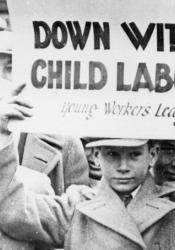Child Labor Laws
In Patrick Park’s Jane Re, Sang owns a grocery store. From an early age, Jane is set to work for her uncle along with her cousins. Jane is singled out compared to the others by always doing something wrong – hanging toilet paper the wrong way, not doing geometrical math fast enough (33), but also by working more than the others. It’s not until Jane learns about child labor laws that she harbors anger for being put to work as a child. Jane’s thoughts in this revelation are, “...and we’d learn about child-labor laws at school, I’d get angry at Sang. That was against the law! You should go to jail! Then he’d snap back - “Then who gonna buy your food? Who gonna pay your clothes?” (34). The audience learns that Sang is cheap from the McDonald’s mouse situation, which explains why he takes advantage of “free” family labor. While the child-labor laws were after Jane Eyre (1800s), they were created before The Flight of Gemma Hardy (1950s/60s), and they were well established by Jane Re (2000, part I estimation of 1 year prior to 9/11). The child-labor laws were started in 1938 to help children not harm their health, education, and/or well-being (Wage and Hour Division). All fields of work have different age restrictions and guidelines, and while Jane had feelings that Sang should be in jail for making her work – she did have an education, food to eat, and a place to live which is why nothing would happen to Sang even if Jane had reported to the police. For children to work, there are specific guidelines to know, “Federal law states that 14-15 year olds cannot work over 8 hours a day, with no more than 3 hours on a school day, and over 40 hours a week, with no more than 18 hours per week while in school. Minors are also not allowed to work before 7am or after 7pm respectively” (OSHA). This is important to the text of Jane Re as she wasn’t even the minimal age of 14 when she began working for her uncle, she recalls memories from eight years old. All Jane knew was school, going to work at Food, then going home to more complaining from her uncle. While some may think that what Sang did was unfair to Jane, others may see what he did to keep food on the table and lights on in the house. The biggest boom surrounding NYC was in the late 90’s for the economy prior to 9/11 happening, but even with an economic boom, it doesn’t mean that local stores didn’t suffer as NYC / Queens / Brooklyn were expensive places to live considering the population by the year 2000 exceeded two million people (2). All of this is essential in understanding why Sang may have been the way he was in part I of Jane Re, but also to recognize that his actions were wrong in overworking minors – going against child-labor laws.
Works Cited:
Bram, Jason. "New York City's Economy before and after September 11." Current Issues in Economics and Finance Second District Highlights, vol. 9, no. 2, Feb. 2003, pp. 1-2.
Child Labor Laws. Progressive Era Photo Exhibit, weebly, progressiveeraexhibition.weebly.com/child-labor-laws.html. Accessed 27 Mar. 2022.
OSHA. "Child Labor Laws - Facts and Misconceptions." OSHA Education Center, American Safety Council, www.oshaeducationcenter.com/articles/child-labor-laws/ lgr=f527d12c-333d-4a07-82c2-0f927bf2131e. Accessed 27 Mar. 2022.
Wage and Hour Division. "Child Labor." U.S. Department of Labor, Wage and Hour Division, www.dol.gov/agencies/whd/child-labor. Accessed 27 Mar. 2022.
Wikipedia contributors. "Timeline of Queens." Wikipedia, The Free Encyclopedia. Wikipedia, The Free Encyclopedia, 6 Mar. 2022. Web. 27 Mar. 2022.

